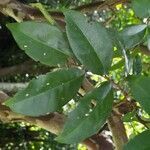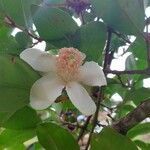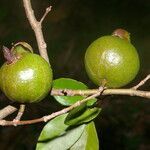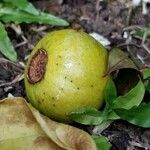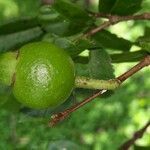A small tree. It grows 3-4 m tall. The branches are angular and hairy. They are reddish. The leaves are papery and 4-10 cm long. There are 8 pairs of secondary veins. The flowers occur singly. They are white and have a scent. The fruit are a medium size and yellow with soft acid pulp. They are like a guava. They have many seeds. The fruit are 6-7 cm across.
A tree 6–12 m tall with quadrangular branches.. Leaves elliptic or oblong-elliptic, 3.8–12 cm long, 2.5–5 cm wide, acuminate at the apex, cuneate at the base, glabrous (or puberulous?) beneath; flowers white, 2.5 cm wide, solitary on slender peduncles; fruit sulphur yellow, round or ellipsoid, 3–6 cm long.
